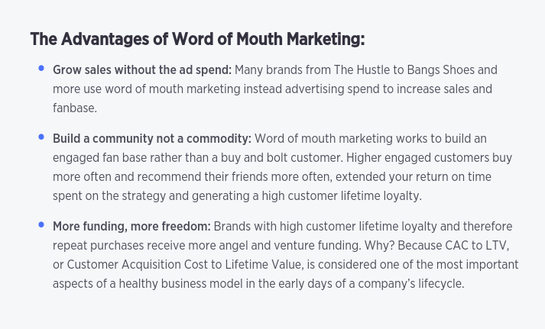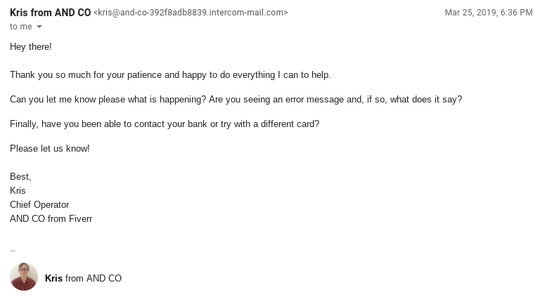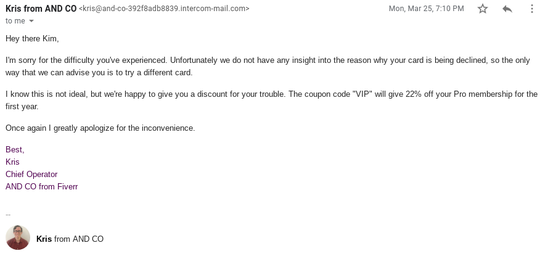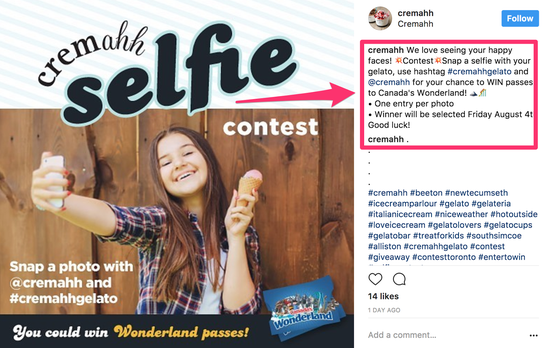Word-of-mouth marketing is the equivalent of a golden ticket for marketing teams: it doesn’t cost you a cent, and it’s the reason behind 13% of all sales globally.
That equates to $6 trillion being spent on products through recommendations. In fact, 90% of consumers are more likely to trust a product if it’s been recommended by a friend.
But here’s the schtick; building up word-of-mouth marketing isn’t easy. And it takes more than a trustworthy brand to make it happen. At its core, word-of-mouth marketing is wrapped up around psychology, brand interaction, and a customer’s experience with a product or service.
Let’s dive into the psychology of word-of-mouth marketing, and how you can help build it up in your company through customer experience.
Word-of-Mouth Marketing: The Psychology Behind It
If a brand isn’t being talked about and if people aren’t excited about their product, then it means the brand is having to spend more money on advertising hoping they do.
That’s where word-of-mouth marketing comes into play. Marketing expert, Jonah Berger, believes there are two driving forces behind word-of-marketing content: social currency and triggers.
The first, social currency, relies on offering something exclusive and making a customer feel special. Like they’re getting in on something before anyone else (e.g., like an exclusive product launch).
The second, triggers, are used by a lot of companies to supercharge their word-of-mouth returns. Berger claims triggers are a ”natural social mechanism that reminds us about a brand or product even when we don’t see advertising.”
![]()
You can plant your own trigger in your customer's heads to get them to recommend your brand without a reason to do so. This is where a carefully crafted customer experience comes into play.
How Word-of-Mouth Referrals Can Be Created With Customer Experience
To get a customer to recommend you through word-of-mouth, they need to be triggered. And to trigger them to do that, your company needs to create a customer experience that goes beyond their expectations.
No fancy bells or whistles. If you over-deliver on what they were expecting (and then some), there’s a good chance they’ll be triggered to mention your brand in the future.
According to Entrepreneur, triggers can be broken down into three categories:
- Architectural: This is a “wow” feature that’s attached to your product’s physical or digital architecture that creates a talking point. Ever wonder why McDonald's pumped so much money into putting playgrounds at all of their restaurants? They knew it would get people talking about family-friendly eating spots.
- Kinetic: Can your product deliver an activity or motion? Does it have a performance factor that will get people talking? Can you get your customers involved in your product enough that it gives them a sense of ownership? Chevrolet did this when they launched the "Corvette Engine Build Experience," which allowed customers to literally build the engine for their new car.
- Generous: How generous is your brand? Are you thinking of the customer first and foremost during their buying journey? Are you marketing a SaaS product that’s willing to give free upgrades or discounts during the onboarding process if you sense friction?
Like invoicing and contracting product, AND.Co, did when I was trying to renew my annual membership. The payment gateway kept rejecting my card payment, so I reached out to their customer support.
I was kept waiting for a grand total of 4 minutes before a customer service rep heard my call for help:
![]()
I could tell Kris was trying to do everything in his power to solve my problem. However, there was no reason why the payment wasn’t being taken, so the company offered out a discount right off the bat to encourage me to keep trying to renew my membership.
![]()
About 5 minutes later, the drama was over, and my membership was renewed—for 22% less. I was already a paying customer, but by offering quick, helpful support, I'll always be triggered to shout about AND.Co to colleagues because of this one simple action.
Always have a budget to be able to deliver a word-of-mouth experience.
It’s obvious from the above example from AND.Co, the company has a budget allocated to manage incidents like this. And your company should too.
If you don’t have a budget that allows employees to give exceptional customer service and follow through with queries that exceed your customer’s expectations, you enter troubled waters. When it comes to word-of-mouth marketing, the biggest mistake isn't overspending, but underspending.
Apple does precisely this to create word-of-mouth marketing. Like the story about the customer who accidentally smashed his laptop, and then got it fixed for free:
A man dropped his brand new MacBook and cracked its screen. Upset, he ponies up some cash and heads to the Apple Store to get it repaired.
An Apple staff member takes his Macbook to the back of the store to examine the damage only to return moments later with a grin saying:
“Sir, it seems like I might have dropped your laptop when checking it out, I’m afraid we’ll have to replace it with a new one, if it’s OK with you.”
And they did.
Take into account any part of the customer journey that could be improved (and exceed expectations) and allocate a budget to it, so your customer service team has room to move if they need to.
Don’t Make Promises in Your Promotional Ads
Now let’s say the discount from AND.Co had been widely advertised as their “go-to” fix when they’re dealing with a customer’s problem.
There would be no reason for me to shout about it. I wouldn’t have included it in this blog.
By announcing all of the things that make your brand exciting to talk about in word-of-marketing in promotional ads, you take away the excitement from your customers announcing it themselves. Ask yourself these questions before you put something word-of-mouth worthy in a paid ad: Why would a customer repeat what you say about yourself in your ads?
Let your customer be the advocate for the trigger, not your ads.
How to Create Word-of-Mouth Marketing for Your Business
Not all types of word-of-mouth marketing are built the same. It can come from:
- Social media posts: Your biggest fans talk about your brand and tag their friends.
- Reviews: Now more than ever, people are searching for other’s approval of a product before they buy it themselves. In turn, these reviews can be repurposed to promote your brand positively.
- User-generated: Like my plug of AND.Co from earlier, you'll usually find user-generated word-of-mouth marketing on social media or in blog posts.
Here’s how to get people talking about your brand.
1. Make Your Content Share-Worthy
According to IMPACT, 86% of Millennials associate user-generated content (USG) with a brand’s quality. Creating share-worthy content is one of the easiest ways to get customers talking about your brand. This could be creating something that customers can use (like a handy blog post or eBook), or gives them an insight on how to solve a pain point.
However, try taking share-worthy one step further by:
- Showcasing UGC on your website, and asking your customers to create their which may be featured on the site in the future (like a glorified review).
- Encourage social sharing by running a competition.
- Get hashtagging. Create a unique hashtag to run alongside a competition or marketing campaign to encourage users to get involved.
Take this example from Canadian gelato shop, Cremahh.
![word of mouth - instagram example]()
They've created their own hashtag for the competition, and they're giving away a prize. It's an excellent example of a simple or a brick and mortar store leveraging their digital platforms to create word-of-mouth marketing.
2. Ask for Reviews
Did you know that, on average, customers read 10 reviews before they make a purchasing decision?
Customers want to know they can trust your product, and reviews are one of the best ways to overcome this buying obstacle.
If you have an e-commerce store, make it as easy as possible for users to rate products. Once they’ve reviewed them, make sure the review appears on your product page, and the reviewer has the chance to share it on their social channels as well.
3. Use Referral Marketing
Using referral marketing is almost like cheating when it comes to word-of-mouth marketing.
Referral marketing allows companies to build communities of loyal fans through rewards. Although word-of-mouth happens organically, referral marketing is a smart way to leverage that buzz and turn it into a recurring marketing channel.
Pro-tip: Using referral marketing software can automate this process for your business. A tool like ReferralCandy can offer up discounts or rewards for customers in exchange for them recommending your product to their friends. You can now even supercharge referral marketing software by integrating it with AdRoll, which allows you to retargeting the leads your customers are already bringing you.
By joining the two software forces, you can build an advertising audience of highly engaged leads through your referral program, have them funneled into AdRoll, and retarget them. You already know the lead is interested in your product-they just need a little extra nurturing.
Final Thoughts on Word of Mouth Marketing
If you’re looking for a cost-effective way to supercharge your marketing, start investing in your word-of-mouth efforts.
By building your company’s success on the foundations of your customer experiences and exceeding their expectations, you give your brand the best chance at being recommended to others.
Word-of-mouth marketing isn’t about techniques or hacks. At its core, it’s about creating meaningful connections with your customers and going above and beyond what they expected from your brand.
Only then can you empower them to be your biggest hero: a brand ambassador.
Kimberlee is a B2B/SaaS Content Writer for ReferralCandy and CandyBar who also helps start-ups fuel their growth through quality, evergreen content.
Last updated on April 23rd, 2025.




